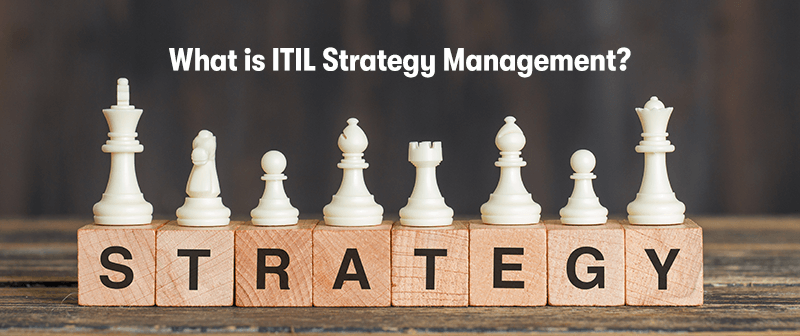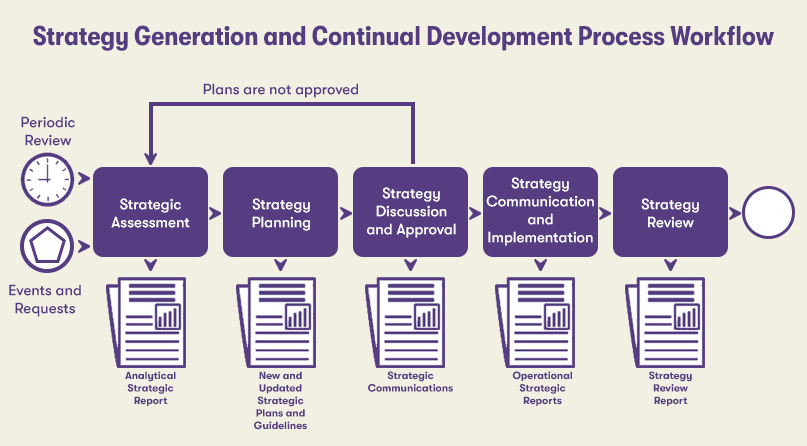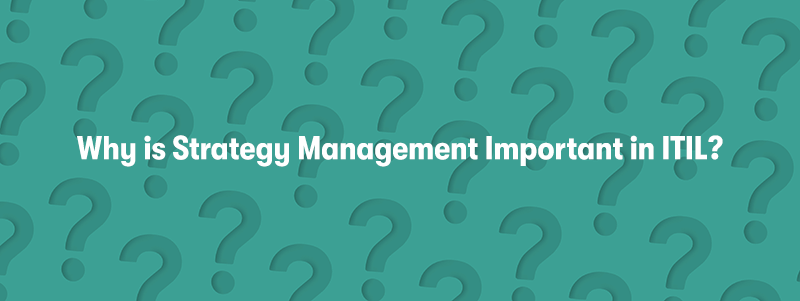ITIL® Strategy Management
Welcome to our comprehensive guide on ITIL Strategy Management, a powerful framework designed to help businesses thrive in the ever-evolving world of IT service management. In today's digital age, aligning your IT services with your organisation's overall business objectives is more crucial than ever. ITIL Strategy Management provides the roadmap to achieve this alignment, focusing on creating, executing, and optimising a service strategy that delivers value to your customers and stakeholders.
In this blog, we'll explore the key components of ITIL Strategy Management, its guiding principles, best practices, and the pivotal role it plays in driving success and continual improvement. Let's dive in!
What is ITIL Strategy Management?

In ITIL 4, Strategy Management is one of the core practices within the "ITIL 4 Leader: Digital and IT Strategy” module. It focuses on developing, maintaining, and executing an IT service strategy that aligns with the organisation's overall business objectives. The ITIL 4 Strategy Management practice plays a crucial role in ensuring that IT services are designed and delivered in a way that brings maximum value to the organisation and its customers. Here are the key aspects of the ITIL 4 Strategy Management practice:
Service Value System (SVS)
The practice of Strategy Management is integrated into the Service Value System (SVS), which represents the overall model for how an organisation creates, delivers, and sustains value through its services. The ITIL SVS considers various inputs, including organisational goals, customer needs, and market trends, to define the IT service strategy effectively.
Guiding Principles
The ITIL 4 framework defines several guiding principles that organisations should adhere to when developing their service strategies. These principles include focusing on value, starting where you are, keeping it simple and practical, and collaborating with stakeholders. The Strategy Management practice ensures that these principles are applied in the strategic decision-making process.
Governance and Risk Management
Strategy Management involves establishing governance practices to ensure that strategic decisions are made by the appropriate stakeholders. It also includes risk management activities to identify potential risks that could impact the successful execution of the IT service strategy.
Continual Improvement
Continuous improvement is a key tenet of ITIL 4, and Strategy Management embraces this concept. The practice encourages regular review and refinement of the IT service strategy to adapt to changing business needs, technology advancements, and customer requirements.
Service Strategy Creation
The primary objective of Strategy Management is to create a service strategy that aligns IT services with the overall business strategy. This involves understanding the organisation's strategic goals, identifying opportunities for improvement, and defining clear and measurable objectives for IT services.
Performance Measurement and Reporting
Strategy Management establishes key performance indicators (KPIs) and metrics to assess the performance of the IT service strategy. Regular reporting and analysis help monitor progress and identify areas that require attention or adjustments.
Collaboration with Strategic Analysts
In some cases, strategic analysts such as consultants or advisors may be involved in the Strategy Management practice. They bring external expertise and insights, helping organisations make informed decisions and enhance their strategic planning process.
The ITIL 4 Strategy Management practice is a dynamic and iterative process that enables organisations to develop IT service strategies that align with business goals, improve service delivery, and adapt to the changing needs of the market and customers.
Strategy Generation and Continual Development Process Workflow

Strategic Assessment
The assessment process involves collaboration between executive leaders, key stakeholders, and, when applicable, strategic analysts (consultants, advisors). Together, they evaluate various aspects, including the direction set by the governing body, the needs of relevant stakeholders, the organisation's current status, and insights from previous strategic review reports.
The comprehensive assessment report comprises an analysis of the organisation's current position and performance, the alignment and implementation of the strategy, and proposals for enhancing the overall strategy.
Strategy Planning
The organisation's executive leaders collaborate with key stakeholders to establish or revise the vision, principles, and objectives of the organisation. Through consultations with key managers, they formulate a set of strategic initiatives that align with these objectives. The outcomes of the planning process are documented and shared with a broader stakeholder audience for review and approval.
If applicable, strategic analysts (consultants, advisors) participate in the planning process to provide valuable insights and expertise.
Strategy Discussion and Approval
Once the proposed strategy is presented to the stakeholders, they engage in discussions and grant approval. In cases where reaching a consensus becomes challenging, decisions are made following the organisation's established decision-making approach. If, for any reason, decisions cannot be reached, any comments and concerns expressed are collected and used as input for a strategic reassessment.
During these discussions, strategic analysts (consultants, advisors) participate when appropriate, offering their valuable input and expertise.
Strategy Communication and Implementation
The strategy, once approved, is communicated to the relevant stakeholders for their consideration and subsequent implementation. The implementation process is carried out in collaboration with other established practices within the organisation.
Strategy Review
The individuals responsible for the strategic initiatives and other key stakeholders assess the progress of strategy execution. The resulting reports may contain recommendations for corrective actions to be taken by the implementing teams. Alternatively, these reports may also prompt a strategic reassessment, depending on the circumstances.
What is the Objective of Strategy Management?

The objective of Strategy Management is to ensure that an organisation's IT service strategy aligns with its overall business strategy and objectives. The primary goal is to create and maintain a clear, coherent, and effective IT service strategy that delivers maximum value to both the organisation and its customers.
Key objectives of ITIL Strategy Management include:
Alignment with Business Goals
To establish a strong alignment between the IT service strategy and the organisation's business objectives. This ensures that IT services support and contribute to the overall success and growth of the business.
Value Creation
To focus on value-driven service management, where IT services are designed and delivered in a way that provides tangible benefits to customers, stakeholders, and the organisation itself.
Risk Management
To identify and manage potential risks associated with the IT service strategy, ensuring that actions are taken to mitigate risks and maintain a secure and reliable IT environment.
Continual Improvement
To foster a culture of continual improvement, where the IT service strategy is regularly reviewed and refined to adapt to changing business needs, technological advancements, and market demands.
Optimisation of Resources
To optimise the allocation and utilisation of resources (e.g., people, technology, finances) to ensure efficient and effective delivery of IT services.
Effective Decision-Making
To establish governance and decision-making processes that involve the right stakeholders and facilitate informed, timely decisions about the IT service strategy.
Enhanced Communication
To facilitate effective communication and collaboration between executive leaders, key stakeholders, and IT teams, ensuring a shared understanding of the IT service strategy and its importance in achieving organisational goals.
By achieving these objectives, ITIL Strategy Management empowers organisations to make strategic, value-driven decisions, ensuring that their IT services remain aligned with business goals and continue to evolve in response to changing market dynamics and customer needs.
Why is Strategy Management Important in ITIL?

Strategy Management is crucial in ITIL4 for several key reasons:
Alignment with Business Objectives
ITIL Strategy Management ensures that the IT service strategy is closely aligned with the overall business objectives of the organisation. This alignment helps IT departments contribute directly to the success and growth of the business by delivering services that support its core mission and goals.
Value Creation
The practice of Strategy Management in ITIL emphasises a value-driven approach to service management. By focusing on delivering value to customers and stakeholders, IT services become more relevant, impactful, and appreciated by the organisation and its users.
Effective Resource Utilisation
Strategy Management helps optimise the allocation and utilisation of resources, including human resources, technology, and finances. It ensures that these resources are used efficiently to deliver services effectively and achieve the desired outcomes.
Risk Management
Through Strategy Management, potential risks associated with the IT service strategy are identified and addressed proactively. This approach minimises the likelihood of service disruptions or security breaches and protects the organisation's reputation.
Continual Improvement
ITIL emphasises the importance of continual improvement, and Strategy Management is no exception. By regularly reviewing and refining the IT service strategy, organisations can adapt to changing business needs, technology advancements, and customer expectations.
Informed Decision-Making
Strategy Management establishes a governance framework for decision-making. This involves involving the right stakeholders, considering various perspectives, and making informed choices about the IT service strategy.
Enhanced Communication and Collaboration
Strategy Management facilitates effective communication and collaboration between different levels of the organisation, including executive leaders, key stakeholders, and IT teams. This alignment fosters a shared understanding of the IT service strategy, promoting better cooperation and coordinated efforts.
Support for IT Service Lifecycle
ITIL is built around the concept of the IT service lifecycle, and Strategy Management plays a pivotal role in the strategy phase. It sets the direction for service design, transition, and operation, ensuring a coherent and integrated approach to service management.
Competitive Advantage
An effective IT service strategy can provide a competitive advantage in the marketplace. By aligning IT services with business goals and continuously improving them, organisations can differentiate themselves, attract customers, and drive growth.
What is Important to Understand About ITIL Strategy Management?
Understanding ITIL Strategy Management is essential for several reasons:
Strategic Alignment
ITIL Strategy Management ensures that IT services are aligned with the organisation's overall business strategy. This alignment is crucial for IT to contribute effectively to the achievement of business objectives.
Value-Centric Approach
The practice focuses on delivering value to customers and stakeholders. Understanding ITIL Strategy Management helps organisations design and deliver services that meet customer needs and expectations, leading to greater satisfaction and loyalty.
Continual Improvement
ITIL Strategy Management promotes a culture of continuous improvement. By understanding this aspect, organisations can continuously assess and refine their IT service strategy to stay relevant and responsive to changing business needs and market demands.
Risk Mitigation
Strategy Management involves identifying and managing potential risks related to the IT service strategy. A proper understanding helps organisations mitigate risks and enhance the resilience of their IT services.
Optimised Resource Utilisation
Understanding Strategy Management enables organisations to optimise resource allocation and utilisation, leading to improved efficiency and cost-effectiveness in delivering IT services.
Governance and Decision-Making
Strategy Management establishes governance structures and decision-making processes. Having a clear grasp of this aspect helps organisations involve the right stakeholders and make informed decisions about their IT service strategy.
Communication and Collaboration
Effective communication and collaboration are critical for successful Strategy Management. Understanding the importance of communication channels and collaboration between various stakeholders ensures a cohesive approach to service management.
Integration with IT Service Lifecycle
Strategy Management is a fundamental component of the ITIL service lifecycle. An appreciation of this integration helps organisations create a well-rounded and seamless service management approach.
Competitive Advantage
A strong IT service strategy can be a differentiator in the market. Understanding ITIL Strategy Management empowers organisations to identify and leverage opportunities for a competitive advantage.
Long-Term Vision
Strategy Management encourages organisations to adopt a long-term vision for their IT services. By understanding this concept, organisations can set realistic and achievable goals that lead to sustainable growth and success.
Adaptability
The world of IT is constantly evolving. Understanding ITIL Strategy Management enables organisations to adapt to technological advancements and changing customer demands while maintaining focus on strategic objectives.
Strategy Management Roles and Responsibilities

In ITIL 4 Strategy Management, various roles and responsibilities are defined to ensure effective planning, execution, and governance of the IT service strategy. The key roles and their corresponding responsibilities include:
Executive Leaders
Executive leaders, often from the senior management team, play a vital role in setting the organisation's strategic direction and overseeing the development and execution of the IT service strategy. Their responsibilities include defining strategic objectives, providing direction, and ensuring alignment with overall business goals.
Key Stakeholders
Key stakeholders represent different groups within the organisation that have a vested interest in the IT service strategy. Their responsibilities involve providing input, feedback, and insights to help shape the strategy and ensure it meets the needs of the organisation and its customers.
Service Strategy Manager
The Service Strategy Manager is responsible for leading and managing the ITIL 4 Strategy Management practice. They oversee the development, implementation, and review of the IT service strategy, ensuring it aligns with business objectives and delivers value to the organisation.
Strategic Analysts (Consultants, Advisors)
Strategic analysts are external experts, consultants, or advisors who may be involved in the planning and assessment processes. They bring specialised knowledge and insights to support decision-making and strategy development.
Governance Board
The Governance Board comprises key decision-makers responsible for ensuring appropriate governance and decision-making within the IT service strategy development process. They approve strategic initiatives, provide guidance, and review progress and performance regularly.
Service Portfolio Manager
The Service Portfolio Manager is responsible for maintaining the service portfolio, which includes the collection of all services offered by the organisation. They ensure that the IT service strategy aligns with the services in the portfolio and supports the organisation's objectives.
Risk Manager
The Risk Manager plays a crucial role in identifying and managing potential risks associated with the IT service strategy. They work to minimise risks and their impact on the organisation's strategic objectives.
Business Relationship Manager
Business Relationship Managers establish and maintain effective relationships between IT and the business units. They ensure that the IT service strategy addresses the specific needs and requirements of different business areas.
Service Design and Transition Teams
These teams work closely with the Service Strategy Manager to ensure that the new or modified services align with the strategic objectives defined in the IT service strategy.
Service Owners
Service Owners are responsible for specific IT services and play a critical role in ensuring that the services are designed, delivered, and continually improved to meet the defined strategic objectives.
Each role in ITIL 4 Strategy Management has distinct responsibilities that contribute to the development, execution, and governance of the IT service strategy. Effective collaboration and clear communication among these roles are essential for the successful implementation of the IT service strategy and its alignment with the organisation's overall business goals.
Final Notes on Strategy Management for ITIL
In conclusion, ITIL 4 Strategy Management is the cornerstone of success for organisations navigating the ever-changing landscape of IT service management. By aligning IT services with business objectives, focusing on value creation, and fostering a culture of continual improvement, Strategy Management empowers businesses to thrive in the digital era.
The key roles, such as executive leaders, strategic analysts, and service owners, work together to craft a robust IT service strategy that delivers tangible benefits to customers and stakeholders. With effective risk management, optimised resource utilisation, and sound decision-making processes, organisations can navigate challenges with confidence and seize new opportunities for growth.
Embracing the principles of ITIL 4 Strategy Management enables businesses to remain agile, adaptable, and competitive in today's dynamic market. By setting a long-term vision, establishing strong governance, and collaborating with key stakeholders, organisations can unlock their full potential and deliver exceptional IT services that drive success.
So, if you're looking to harness the power of IT service management and position your organisation for sustainable growth, embracing ITIL 4 Strategy Management is the key to unlocking your path to success. With ITIL 4, your IT services can become the driving force behind your organisation's journey towards excellence in the digital age.


